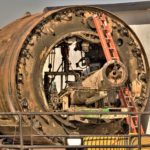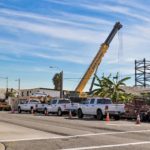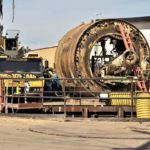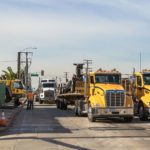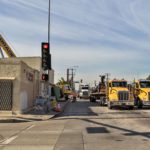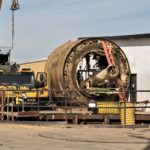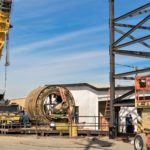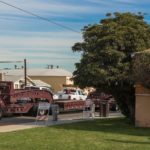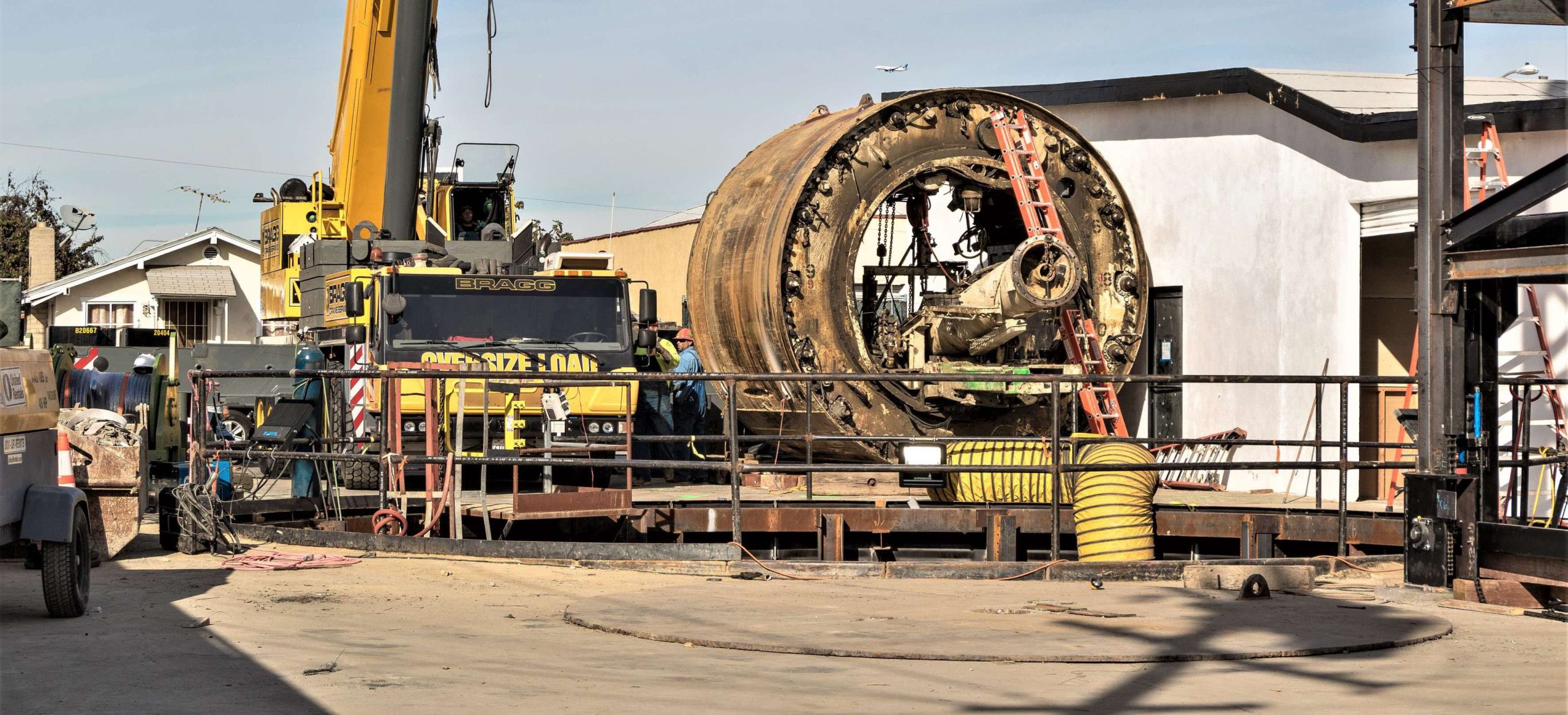
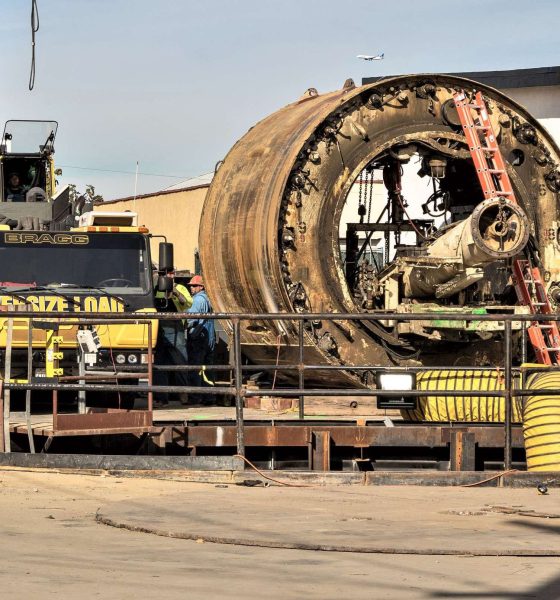
News
Elon Musk’s Boring Company extracts TBM segments as tunnel debut nears
On November 27, a large crew of Boring Company employees and contractors converged upon the company’s Praire Avenue work site, home of a number of recent milestones for the tunneling startup’s 2-mile long test tunnel situated beneath Hawthorne, California. Just a handful of blocks away from SpaceX’s main rocket factory, The Boring Co. completed the removal of its first tunnel boring machine (TBM), allowing the company to begin cleaning up the site, preparing it for the installation of a brand new elevator shaft capable of transporting vehicles or custom sleds into or out of the tunnel.
The extraction of Godot, the tunneling startup’s first TBM, was shared by the company on its official Twitter account. Godot is a conventional TBM, and during the company’s information session earlier this year, Elon Musk noted that the machine would be succeeded by Line-Storm, which is “essentially a hybrid between a conventional boring machine and Proof-Rock, a fully Boring Company-designed machine.” Being electric-powered, Proof-rock is expected have 3x more power and operate 10-15x times faster than Godot.
Godot (our 1st TBM) is out of the ground! Getting excited for Hawthorne test tunnel opening in a few weeks pic.twitter.com/5DF2sDtmIo
— The Boring Company (@boringcompany) November 28, 2018
On the same day as the TBM removal began, news broke that The Boring Company had settled with a number of Los Angeles-based complainants and chosen to cancel a proposed extension of the test tunnel expected to run under Sepulveda Boulevard. Counter to a narrative coming out of several media outlets that TBC had effectively canceled an important tunnel against the company’s will, Elon Musk clarified that the actual explanation for the change in plans was largely positive, with the company believing that it no longer needs additional practice thanks to experience gained through the construction of its first test tunnel.
Instead of pursuing the Sepulveda tunnel extension, The Boring Company instead believes that it can and should move directly to a more ambitious network of tunnels to crisscross subterranean Los Angeles, known as the Dugout Loop thanks to the inclusion of Dodger Stadium as a primary destination.
This is completely backwards. Based on what we’ve learned from the Hawthorne test tunnel, we’re moving forward with a much larger tunnel network under LA. Won’t need a second test tunnel under Sepulveda.
— Elon Musk (@elonmusk) November 29, 2018
Amidst the Boring Company’s preparations for the December 10 opening party of its Hawthorne test tunnel, the site of the Prairie Ave pit, which is expected to be the location of the Boring Company’s prototype garage-elevator concept, has shown lots of activity. Just recently, Teslarati photographer Pauline Acalin was able to capture images of multiple semi-trucks loading and transporting extricated TBM segments.
Based on the photographs we acquired, dozens of employees and/or contractors were present during the TBM extraction. The removal and transportation of the TBM segments from the Prairie Ave. pit appear to have been completed in ~24 hours from start to finish as well, as other members of the Teslarati team who visited the area not long after the photos were taken noted that the boring machine segments have already been transported elsewhere when they arrived.
- The Boring Company began removing Godot, its first tunnel boring machine, on Nov. 27 and completed the removal the following day. (Pauline Acalin)
The Boring Company began removing Godot, its first tunnel boring machine, on Nov. 27 and completed the removal the following day. (Pauline Acalin)
The extraction of Godot from the Prairie Ave. site bodes well for The Boring Company’s planned operations in the future. Conventional tunneling practices, after all, usually involve leaving expensive TBM components such as the cutting head underground after work is complete due to high costs associated with their retrieval. In classic Elon Musk fashion, the Boring Company has opted for reusability instead, seemingly using its prototype garage-elevator concept as an exit point for its TBM segments.
The experience gained by The Boring Company in its Hawthorne test tunnel would help the tunneling startup tackle its most ambitious project to date — Chicago’s upcoming downtown to O’Hare high-speed transport line, which is expected to break ground as soon as the project’s permits are completed. Updates about the Chicago project have been scarce so far, though photographs taken by Teslarati photographers suggest that a gantry for the Chicago tunnel line, as well as what appears to be a next-generation TBM, is under construction.
Here’s a little video we made to commemorate our work covering The Boring Company.

Investor's Corner
Tesla Full Self-Driving statistic impresses Wall Street firm: ‘Very close to unsupervised’
The data shows there was a significant jump in miles traveled between interventions as Tesla transitioned drivers to v14.1 back in October. The FSD Community Tracker saw a jump from 441 miles to over 9,200 miles, the most significant improvement in four years.

Tesla Full Self-Driving performance and statistics continue to impress everyone, from retail investors to Wall Street firms. However, one analyst believes Tesla’s driving suite is “very close” to achieving unsupervised self-driving.
On Tuesday, Piper Sandler analyst Alexander Potter said that Tesla’s recent launch of Full Self-Driving version 14 increased the number of miles traveled between interventions by a drastic margin, based on data compiled by a Full Self-Driving Community Tracker.
🚨 Piper Sandler reiterated its Overweight rating and $500 PT on Tesla $TSLA stock
Analyst Alexander Potter said FSD is near full autonomy and latest versions showed the largest improvement in disengagements, from 440 miles to 9,200 miles between critical interventions pic.twitter.com/u4WCLfZcA9
— TESLARATI (@Teslarati) December 9, 2025
The data shows there was a significant jump in miles traveled between interventions as Tesla transitioned drivers to v14.1 back in October. The FSD Community Tracker saw a jump from 441 miles to over 9,200 miles, the most significant improvement in four years.
Interestingly, there was a slight dip in the miles traveled between interventions with the release of v14.2. Piper Sandler said investor interest in FSD has increased.
Full Self-Driving has displayed several improvements with v14, including the introduction of Arrival Options that allow specific parking situations to be chosen by the driver prior to arriving at the destination. Owners can choose from Street Parking, Parking Garages, Parking Lots, Chargers, and Driveways.
Additionally, the overall improvements in performance from v13 have been evident through smoother operation, fewer mistakes during routine operation, and a more refined decision-making process.
Early versions of v14 exhibited stuttering and brake stabbing, but Tesla did a great job of confronting the issue and eliminating it altogether with the release of v14.2.
Tesla CEO Elon Musk also recently stated that the current v14.2 FSD suite is also less restrictive with drivers looking at their phones, which has caused some controversy within the community.
Although we tested it and found there were fewer nudges by the driver monitoring system to push eyes back to the road, we still would not recommend it due to laws and regulations.
Tesla Full Self-Driving v14.2.1 texting and driving: we tested it
With that being said, FSD is improving significantly with each larger rollout, and Musk believes the final piece of the puzzle will be unveiled with FSD v14.3, which could come later this year or early in 2026.
Piper Sandler reaffirmed its $500 price target on Tesla shares, as well as its ‘Overweight’ rating.
News
Tesla begins Holiday Update rollout with some surprise features
On Monday, just a few days after Tesla first announced the Holiday Update, people started reporting that it was being deployed to owners.

Tesla has started the rollout of the 2025 Holiday Update, as several owners reported it had arrived in their cars via a software update.
Tesla’s Holiday Update is rolling out as Software Version 2025.44.25.1, and includes several new features. We did an extensive breakdown of what was included in another article, but we’ll list the new additions below:
- Grok with Navigation Commands (Beta) – Grok will now add and edit destinations.
- Tesla Photobooth – Take pictures inside your car using the cabin-facing camera
- Dog Mode Live Activity – Check on your four-legged friend on your phone through periodic snapshots taken of the cabin
- Dashcam Viewer Update – Includes new metrics, like steering wheel angle, speed, and more
- Santa Mode – New graphics, trees, and a lock chime
- Light Show Update – Addition of Jingle Rush light show
- Custom Wraps and License Plates – Colorizer now allows you to customize your vehicle even further, with custom patterns, license plates, and tint
- Navigation Improvements – Easier layout and setup
- Supercharger Site Map – Starting at 18 pilot locations, a 3D view of the Supercharger you’re visiting will be available
- Automatic Carpool Lane Routing – Navigation will utilize carpool lanes if enabled
- Phone Left Behind Chime – Your car will now tell you if you left a phone inside
- Charge Limit Per Location – Set a charge limit for each location
- ISS Docking Simulator – New game
- Additional Improvements – Turn off wireless charging pad, Spotify improvements, Rainbow Rave Cave, Lock Sound TRON addition
On Monday, just a few days after Tesla first announced the Holiday Update, people started reporting that it was being deployed to owners.
We noticed a new Tesla software update 2025.44.25.1 on a Model Y AWD LR (2022) in Florida, United States. View the rollout of this update here: https://t.co/rPqISQaNkM
— Teslascope (@teslascope) December 8, 2025
It seems the release is a bit of an apology to a particular group, as it has only made its way to Hardware 3 vehicles, particularly the ones using the AMD Ryzen chip.
Tesla has excluded FSD-purchased and subscribed vehicles that are utilizing Hardware 3, so it seems there is a strategy to this limited rollout.
Two Surprise Additions
Tesla has added two additional features with the Holiday Update, which include a new Storage Space for Dashcam feature that shows how much space you have used and remaining on your USB drive.
Additionally, Tesla gamified Supercharging with a new “Charging Passport” feature, which we reported on earlier today.
News
Tesla announces major milestone at Gigafactory Shanghai
First deliveries started in December 2019, with the first units being given to employees. By the end of 2020, the plant was building cars at a run rate of around 150,000 vehicles annually.
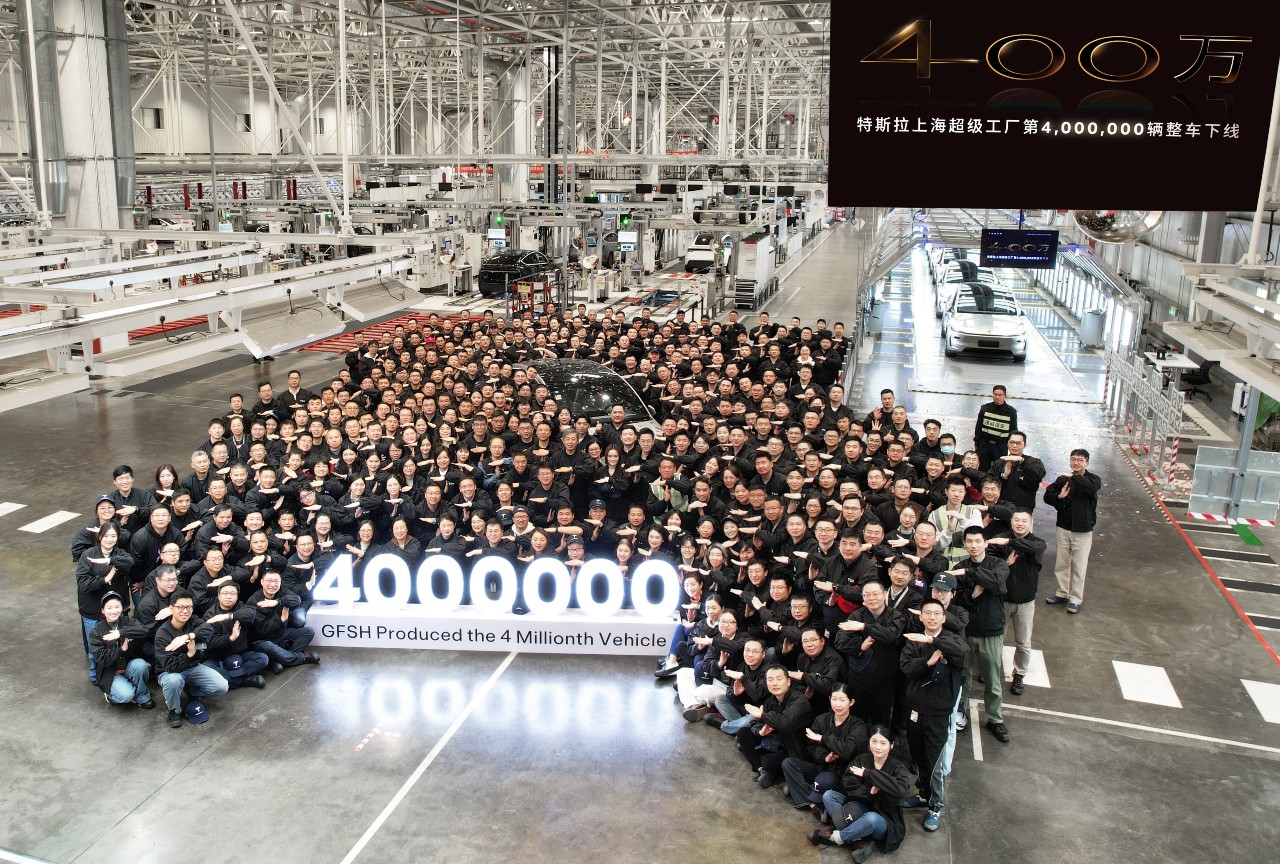
Tesla has announced a major milestone at its Chinese manufacturing facility, Gigafactory Shanghai, confirming on Monday that it had built its four millionth vehicle.
Tesla Gigafactory Shanghai first started building cars back in October 2019 with Model 3 assembly, just ten months after the company broke ground on the plant’s 86-hectare piece of land.
First deliveries started in December 2019, with the first units being given to employees. By the end of 2020, the plant was building cars at a run rate of around 150,000 vehicles annually. Production continued to ramp up, and by September 2023, less than three years after it started building Tesla’s EVs, it had built its two millionth vehicle.
Fast forward to December 2025, and Tesla has confirmed that four million cars have rolled off of production lines at the plant, a major milestone in the six short years it has been active:
Produced our 4 millionth vehicle at Gigafactory Shanghai🎉
Thanks to all our owners and supporters❤️ pic.twitter.com/DayVXUr220— Tesla Asia (@Tesla_Asia) December 8, 2025
The capacity at Giga Shanghai is exceeding 950,000 vehicles per year, and this year, the company has delivered 675,000 cars through the first three quarters. It is also the only plant to manufacture the Model Y L, a longer wheel-based configuration of the all-electric crossover that is exclusive to the Chinese market.
Gigafactory Shanghai’s four million cars have not all stayed within the domestic market, either. For a considerable period, the factory was exporting a significant portion of its monthly production to Europe, helping Gigafactory Berlin supplement some Model Y volume and all of its Model 3 deliveries. This is due to the Berlin plant’s exclusive production plans for the Model 3.
The site is one of the most crucial in the company’s global plans, and Gigafactory Shanghai’s incredible pace, which has led to four million production units in just about six years. It’s fair to say that it won’t be long until we’re seeing Tesla celebrate the plant’s five millionth vehicle produced, which should happen sometime late next year or in early 2027, based on its current manufacturing pace.
The company also builds the Megapack on the property in an adjacent Megafactory.
